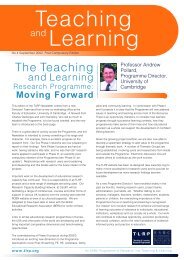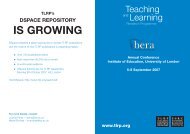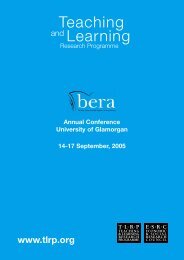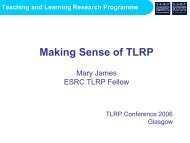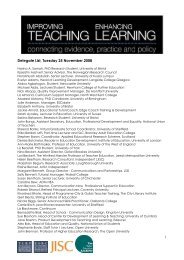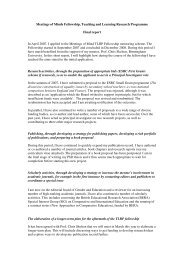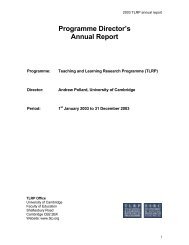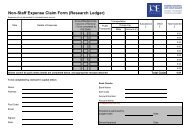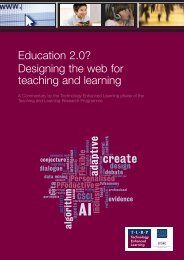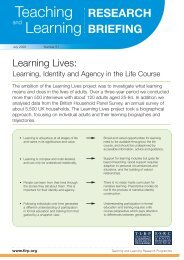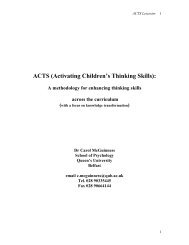Principles into practice: A teacher's guide to research evidence on ...
Principles into practice: A teacher's guide to research evidence on ...
Principles into practice: A teacher's guide to research evidence on ...
- No tags were found...
You also want an ePaper? Increase the reach of your titles
YUMPU automatically turns print PDFs into web optimized ePapers that Google loves.
9acquisiti<strong>on</strong> of knowledge and skills,”they c<strong>on</strong>clude.However, if a child’s ownbackground, pers<strong>on</strong>ality andstrengths fit in well with the ethosand curriculum of their school, theyare more likely <str<strong>on</strong>g>to</str<strong>on</strong>g> succeed. Pollardand Filer found that middle classchildren attending independent orselective schools had a morec<strong>on</strong>sistent identity whether theywere at home, at school or out withfriends. But children incomprehensives “often experienceddisparities in the discourse, valuesand expectati<strong>on</strong>s of significan<str<strong>on</strong>g>to</str<strong>on</strong>g>thers in their homes, schools andpeer groups.” This meant theydeveloped more “fragmentedidentities”, which could make itharder for them <str<strong>on</strong>g>to</str<strong>on</strong>g> learn andsucceed in school.One of the less<strong>on</strong>s is that childrenneed <str<strong>on</strong>g>to</str<strong>on</strong>g> be seen more in the round,difficult though this may be in aworld which “presses remorselesslyfor short-term performance”. The<str<strong>on</strong>g>research</str<strong>on</strong>g>ers insist that: “Maximisingthe potential of children and youngpeople calls for a more appropriateunderstanding of them as socialac<str<strong>on</strong>g>to</str<strong>on</strong>g>rs within their cultures andcommunities, and of how educati<strong>on</strong>fits <str<strong>on</strong>g>in<str<strong>on</strong>g>to</str<strong>on</strong>g></str<strong>on</strong>g>, and c<strong>on</strong>tributes <str<strong>on</strong>g>to</str<strong>on</strong>g>, theirlives as a whole”.Identity and Learning ProgrammeBooks associated with the programmeinclude:The Social World of Children’s Learning,Pollard and Filer (Cassell)The Social World of Pupil Career, Pollardand Filer (C<strong>on</strong>tinuum)The Social World of Pupil Assessment inPrimary School, Filer and Pollard(C<strong>on</strong>tinuum)Reflective Teaching, Pollard(C<strong>on</strong>tinuum)Towards schoolswhere every<strong>on</strong>ebel<strong>on</strong>gsTeachers often thinkabout inclusi<strong>on</strong> in termsof children with specialeducati<strong>on</strong>al needs, but<str<strong>on</strong>g>research</str<strong>on</strong>g>ers <strong>on</strong> the Understandingand DevelopingInclusive Practices in Schoolsproject sought <str<strong>on</strong>g>to</str<strong>on</strong>g> broaden thedefiniti<strong>on</strong>. They worked overthree years with a network of25 schools <str<strong>on</strong>g>to</str<strong>on</strong>g> help groups ofstaff engage with <str<strong>on</strong>g>evidence</str<strong>on</strong>g>about pupils’ experience ofschool and about their own<str<strong>on</strong>g>practice</str<strong>on</strong>g>.Staff in the participatingschools came <str<strong>on</strong>g>to</str<strong>on</strong>g> recognisethat barriers <str<strong>on</strong>g>to</str<strong>on</strong>g> pupil-learningoften stem from teachers’misplaced assumpti<strong>on</strong>s aboutwhat their pupils can do andhow best <str<strong>on</strong>g>to</str<strong>on</strong>g> teach them. What’sneeded is not just new waysof working, but new ways ofthinking – and this takes time.Researchers found that itcan be more useful for aschool enquiry <str<strong>on</strong>g>to</str<strong>on</strong>g> focus <strong>on</strong> aspecific issue of c<strong>on</strong>cernrather than whole schoolchange. For example, <strong>on</strong>eprimary school was c<strong>on</strong>cernedbecause children’s languageskills were holding them back.They devised a questi<strong>on</strong>naireafter c<strong>on</strong>sulting the children.Answers <str<strong>on</strong>g>to</str<strong>on</strong>g> “What d<strong>on</strong>’t youlike about writing?” includedCREATING INCLUSIVE CULTURESThe Index forInclusi<strong>on</strong> was used<str<strong>on</strong>g>to</str<strong>on</strong>g> inform the acti<strong>on</strong><str<strong>on</strong>g>research</str<strong>on</strong>g> This is anexample of theindica<str<strong>on</strong>g>to</str<strong>on</strong>g>rs it uses:Building community• Every<strong>on</strong>e is made<str<strong>on</strong>g>to</str<strong>on</strong>g> feel welcome.• Students help eachother.• Staff collaboratewith each other.• Staff and studentstreat <strong>on</strong>e anotherwith respect.• There is apartnershipbetween staff andparents/carers.• Staff andgovernors workwell <str<strong>on</strong>g>to</str<strong>on</strong>g>gether.• All local communitiesare involved inthe school.Establishinginclusive values• There are highexpectati<strong>on</strong>s for allstudents.• Staff, governors,students andparents/carersshare a philosophyof inclusi<strong>on</strong>.“It hurts my hand” and “Ittakes me a l<strong>on</strong>g time <str<strong>on</strong>g>to</str<strong>on</strong>g> thinkwhat I’m going <str<strong>on</strong>g>to</str<strong>on</strong>g> write”. Whatchildren did like about writingcentred <strong>on</strong> the chance <str<strong>on</strong>g>to</str<strong>on</strong>g> usetheir imaginati<strong>on</strong>s.A teacher commented: “Itmade me try <str<strong>on</strong>g>to</str<strong>on</strong>g> analysethings… because we couldlook at the children’s answersand so started <str<strong>on</strong>g>to</str<strong>on</strong>g> think, well ifthey’re thinking this way…how do we have <str<strong>on</strong>g>to</str<strong>on</strong>g> think <str<strong>on</strong>g>to</str<strong>on</strong>g> getthem <str<strong>on</strong>g>to</str<strong>on</strong>g> change their mindsabout what they’re doing?”Teachers saw that teachingthe curriculum harder andl<strong>on</strong>ger wouldn’t improve manypupils’ learning outcomes.Rather, they needed <str<strong>on</strong>g>to</str<strong>on</strong>g> thinkabout fac<str<strong>on</strong>g>to</str<strong>on</strong>g>rs that underpinlearning, such as pupils’ selfesteem,enjoyment and theirview of themselves as learners.The <str<strong>on</strong>g>research</str<strong>on</strong>g>ers c<strong>on</strong>cluded:“Addressing both underachievementand inclusi<strong>on</strong>requires that the nati<strong>on</strong>alfocus <strong>on</strong> highly measurableoutcomes of school bebroadened <str<strong>on</strong>g>to</str<strong>on</strong>g> include theseunderlying fac<str<strong>on</strong>g>to</str<strong>on</strong>g>rs.”Project c<strong>on</strong>tact mel.ainscow@man.ac.ukFurther reading: Improving Scools,Developing Inclusi<strong>on</strong>, Ainscow,Booth and Dys<strong>on</strong> (Routledge)• Students areequally valued.• Staff and studentstreat <strong>on</strong>e anotheras human beingsas well asoccupants of a ‘role’.• Staff seek <str<strong>on</strong>g>to</str<strong>on</strong>g>remove barriers <str<strong>on</strong>g>to</str<strong>on</strong>g>learning andparticipati<strong>on</strong> in allaspects of theschool.From the Centre forStudies <strong>on</strong> InclusiveEducati<strong>on</strong> (CSIE)inclusi<strong>on</strong>.uwe.ac.uk/csie/indexlaunch.htm



